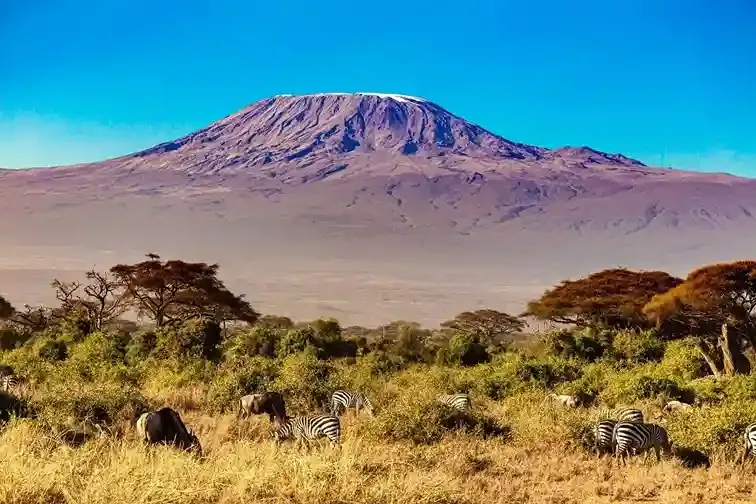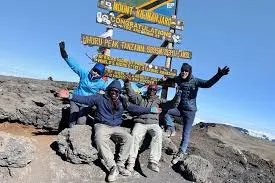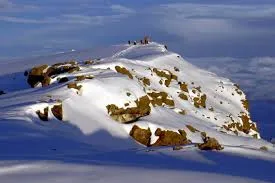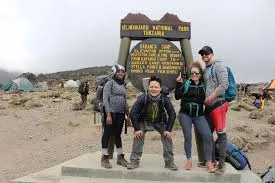Interesting Facts About Mount Kilimanjaro
Mount Kilimanjaro, Africa’s highest peak, is a treasure trove of natural wonders and cultural significance. Standing tall in Tanzania, this dormant volcano captivates adventurers worldwide. From its unique ecosystems to its storied climbing history, Kilimanjaro offers more than just a trek—it’s a journey through geological marvels and breathtaking landscapes. Join Capable Africa Tours as we uncover fascinating facts about Mount Kilimanjaro to inspire your next adventure!
Plan Your Kilimanjaro Adventure
Why Mount Kilimanjaro Fascinates Adventurers
Kilimanjaro isn’t just a mountain—it’s a global icon of adventure, nature, and culture. As the tallest free-standing mountain in the world, it draws thousands of climbers annually, each seeking to conquer its 5,895-meter summit. With Capable Africa Tours, you can explore this majestic peak while learning its incredible secrets. Below, we dive into the most interesting facts about Mount Kilimanjaro, blending geological wonders, cultural insights, and practical tips for your trek.
Top 10 Fascinating Facts About Mount Kilimanjaro
- Africa’s Highest Peak: At 5,895 meters (19,341 feet), Kilimanjaro’s Uhuru Peak on Kibo cone is the highest point in Africa, towering over Tanzania’s plains.
- Dormant Volcano: Kilimanjaro is a stratovolcano with three cones—Kibo, Mawenzi (5,149 m), and Shira (4,005 m). Kibo is dormant, with minor gas emissions last reported in the 1800s.
- Five Unique Ecosystems: The mountain spans five climate zones: rainforest, heath, moorland, alpine desert, and arctic summit, each hosting distinct flora and fauna.
- Tallest Free-Standing Mountain: Unlike peaks in mountain ranges, Kilimanjaro stands alone, rising dramatically from the surrounding savanna.
- Seven Climbing Routes: Routes like Lemosho, Machame, and Marangu offer diverse experiences, with Capable Africa Tours guiding you through scenic paths like Lemosho for optimal acclimatization.
- Cultural Significance: The Chagga people, native to the region, revere Kilimanjaro as a sacred site, with myths tying it to their spiritual heritage.
- Shrinking Glaciers: Kilimanjaro’s iconic ice fields are receding due to climate change, with estimates suggesting they may vanish by 2030–2050.
- First Summit in 1889: Hans Meyer and Ludwig Purtscheller were the first to summit Kilimanjaro, marking a historic milestone in mountaineering.
- Wildlife Diversity: The rainforest zone teems with colobus monkeys, blue monkeys, and birds like the Hartlaub’s turaco, while higher zones feature unique plants like giant groundsels.
- Global Trekking Magnet: Over 35,000 climbers attempt Kilimanjaro annually, with success rates of 85–90% on longer routes like Lemosho, offered by Capable Africa Tours.
Geological and Historical Insights
Mount Kilimanjaro’s formation and history are as captivating as its trails. Formed over a million years ago through volcanic activity, its three cones tell a story of tectonic shifts and eruptions. The Chagga people’s oral traditions add a layer of mystique, with tales of gods residing in its peaks. Capable Africa Tours integrates these stories into our treks, enriching your climb with cultural context.
Key Geological Facts
| Feature | Details |
|---|---|
| Formation Age | Over 1 million years ago |
| Volcanic Cones | Kibo (5,895 m), Mawenzi (5,149 m), Shira (4,005 m) |
| Geological Type | Stratovolcano (dormant) |
| Glacier Coverage | ~2 km² (shrinking since early 20th century) |
| Last Eruption | ~360,000 years ago (Kibo cone) |
Historical Milestones
- 1889: First confirmed summit by Hans Meyer and Ludwig Purtscheller.
- 1930s: Establishment of Marangu Route, the first organized climbing path.
- 1977: Kilimanjaro National Park established to protect the mountain’s ecosystems.
- 1987: UNESCO designates Kilimanjaro a World Heritage Site.
- 2013: Fastest solo ascent by Kilian Jornet in 7 hours, 14 minutes.
Discover Kilimanjaro’s Wonders
Watch this video to explore Mount Kilimanjaro’s breathtaking landscapes and learn why climbing with Capable Africa Tours is the ultimate adventure.
Climbing Mount Kilimanjaro
Climbing Kilimanjaro is a bucket-list adventure, but it requires preparation. Below are quantitative insights to help you plan your trek with Capable Africa Tours, ensuring a safe and successful climb.
Kilimanjaro Climbing Stats
| Metric | Value |
|---|---|
| Height | 5,895 m / 19,341 ft |
| Annual Climbers | ~35,000 |
| Summit Success Rate | 65–90% (route-dependent) |
| Climbing Routes | 7 (Lemosho, Machame, Marangu, etc.) |
| Typical Duration | 5–9 days |
| Average Daily Hiking | 5–8 hours |
Route Comparison
| Route | Distance | Days | Success Rate | Features |
|---|---|---|---|---|
| Lemosho | 70 km | 7–8 | 85–90% | Scenic, less crowded |
| Machame | 62 km | 6–7 | 80–85% | Popular, diverse views |
| Marangu | 72 km | 5–6 | 65–70% | Hut-based, beginner-friendly |
Flora and Fauna of Kilimanjaro
Kilimanjaro’s five ecological zones host a remarkable array of plants and animals. From lush rainforests to barren summits, each zone offers unique biodiversity. Capable Africa Tours ensures eco-conscious treks to preserve this natural heritage.
Notable Wildlife and Plants
- Rainforest (1,800–2,800 m): Colobus monkeys, blue monkeys, turacos, and orchids thrive in this humid zone.
- Heath/Moorland (2,800–4,000 m): Giant heather and lobelias dominate, with occasional sightings of small mammals like rock hyraxes.
- Alpine Desert (4,000–5,000 m): Sparse vegetation like everlasting flowers; minimal wildlife due to harsh conditions.
- Arctic Summit (5,000–5,895 m): Barren with glaciers; no significant flora or fauna.
Preparing for Your Kilimanjaro Adventure
Climbing Kilimanjaro requires physical and mental preparation. Capable Africa Tours provides expert guidance to ensure you’re ready. Focus on cardiovascular fitness, strength training, and gear preparation for a successful summit.
Preparation Tips
- Fitness Training: Run or hike 4–5 times weekly for 45–60 minutes to build endurance.
- Strength Exercises: Include squats, lunges, and core workouts for steep terrain.
- Gear Checklist: Waterproof boots, merino wool layers, trekking poles, and a -15°C sleeping bag.
- Altitude Prep: Practice hikes above 2,500 m or use altitude simulation gear.
- Mental Readiness: Stay positive, pace yourself, and follow your guide’s advice.
Gear Rentals
Capable Africa Tours offers rentals for sleeping bags, down jackets, and trekking poles, ensuring you travel light without compromising on quality.
Climb Mount Kilimanjaro with Capable Africa Tours
Ready to conquer Africa’s highest peak? Join Capable Africa Tours for a safe, scenic, and unforgettable Kilimanjaro adventure. Our expert guides, eco-friendly practices, and tailored itineraries ensure a high summit success rate. Book now to secure your spot!
- 85–90% summit success on longer routes
- Eco-conscious treks supporting local communities
- High-quality gear rentals for convenience
- Experienced guides and porters for safety
- All-inclusive packages with meals and transfers
Limited spots available for Kilimanjaro treks—book now to climb with Capable Africa Tours!
Plan Your Trek Now


